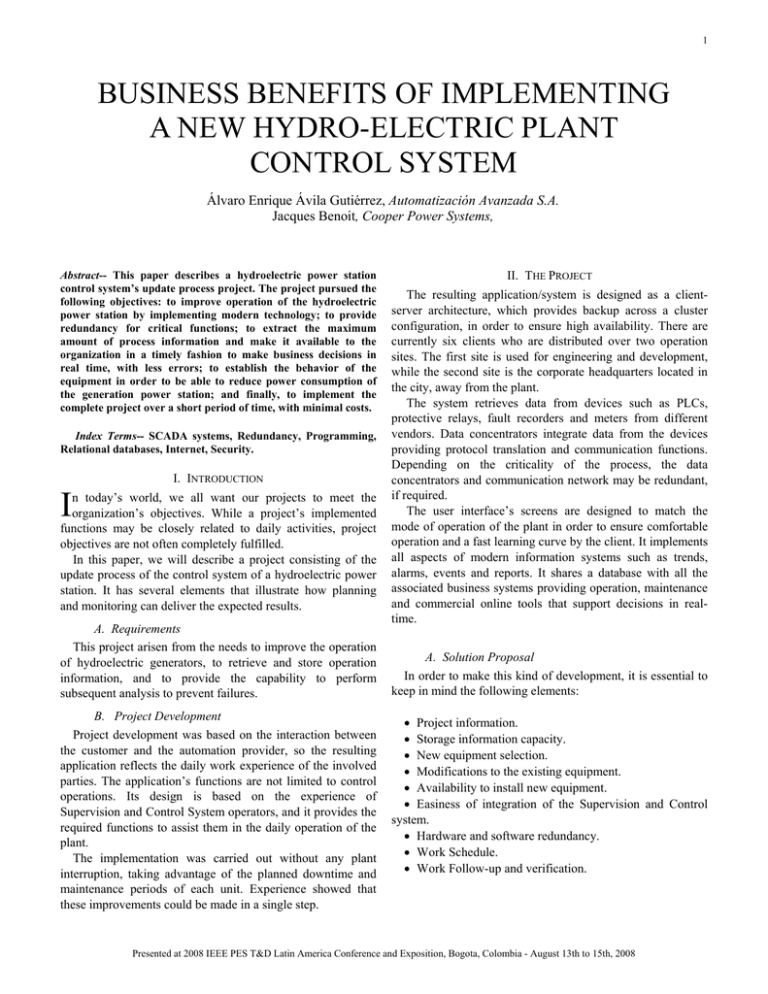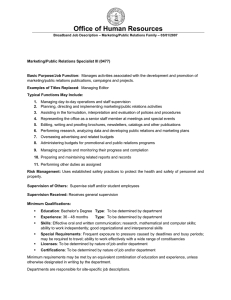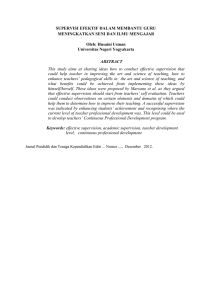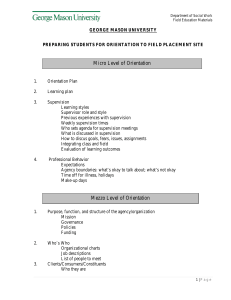II. T P The resulting application/system is designed as a client-
advertisement

1 BUSINESS BENEFITS OF IMPLEMENTING A NEW HYDRO-ELECTRIC PLANT CONTROL SYSTEM Álvaro Enrique Ávila Gutiérrez, Automatización Avanzada S.A. Jacques Benoit, Cooper Power Systems, Abstract-- This paper describes a hydroelectric power station control system’s update process project. The project pursued the following objectives: to improve operation of the hydroelectric power station by implementing modern technology; to provide redundancy for critical functions; to extract the maximum amount of process information and make it available to the organization in a timely fashion to make business decisions in real time, with less errors; to establish the behavior of the equipment in order to be able to reduce power consumption of the generation power station; and finally, to implement the complete project over a short period of time, with minimal costs. Index Terms-- SCADA systems, Redundancy, Programming, Relational databases, Internet, Security. I. INTRODUCTION I n today’s world, we all want our projects to meet the organization’s objectives. While a project’s implemented functions may be closely related to daily activities, project objectives are not often completely fulfilled. In this paper, we will describe a project consisting of the update process of the control system of a hydroelectric power station. It has several elements that illustrate how planning and monitoring can deliver the expected results. A. Requirements This project arisen from the needs to improve the operation of hydroelectric generators, to retrieve and store operation information, and to provide the capability to perform subsequent analysis to prevent failures. B. Project Development Project development was based on the interaction between the customer and the automation provider, so the resulting application reflects the daily work experience of the involved parties. The application’s functions are not limited to control operations. Its design is based on the experience of Supervision and Control System operators, and it provides the required functions to assist them in the daily operation of the plant. The implementation was carried out without any plant interruption, taking advantage of the planned downtime and maintenance periods of each unit. Experience showed that these improvements could be made in a single step. II. THE PROJECT The resulting application/system is designed as a clientserver architecture, which provides backup across a cluster configuration, in order to ensure high availability. There are currently six clients who are distributed over two operation sites. The first site is used for engineering and development, while the second site is the corporate headquarters located in the city, away from the plant. The system retrieves data from devices such as PLCs, protective relays, fault recorders and meters from different vendors. Data concentrators integrate data from the devices providing protocol translation and communication functions. Depending on the criticality of the process, the data concentrators and communication network may be redundant, if required. The user interface’s screens are designed to match the mode of operation of the plant in order to ensure comfortable operation and a fast learning curve by the client. It implements all aspects of modern information systems such as trends, alarms, events and reports. It shares a database with all the associated business systems providing operation, maintenance and commercial online tools that support decisions in realtime. A. Solution Proposal In order to make this kind of development, it is essential to keep in mind the following elements: • Project information. • Storage information capacity. • New equipment selection. • Modifications to the existing equipment. • Availability to install new equipment. • Easiness of integration of the Supervision and Control system. • Hardware and software redundancy. • Work Schedule. • Work Follow-up and verification. Presented at 2008 IEEE PES T&D Latin America Conference and Exposition, Bogota, Colombia - August 13th to 15th, 2008 2 • Daily, weekly, monthly and annual reports. • Projections for decision-making. Fig. 1. Supervisor and Control system Architecture. B. Life cycle The Project has a reach and a purpose in a determined time frame in which we should consider the following concepts: • • • • • • • • • • Scalability Reliability Consistency with the needs Integration with new products Easiness of configuration Easiness of operation Easiness of maintenance Event prediction Event Analysis Inter database data exchange C. The Data There are two main groups of information. The first one is the operational data: it refers to measurements and the system state. This type of data allows us to have a good view of the state of the equipment, as it includes the faults and signal statuses. The quantity of statuses can be roughly 10,000 points. The second group is the production data: the amount of statuses can be around 1000 points. The secret to the success of information broadcast towards the organization lies in a good understanding of the enterprise. It gives a competitive edge in the market. For this reason the data should includes: • • • • • • Scheduled daily generation. Production data. Units, connection and disconnection events. Development of the dam. Production history data. Dam historical data. D. Project startup. In the substation, there is a large variety of equipment that has been installed in the last 4 years. All this equipment comes from different vendors. To eliminate incompatibility between protocols and communication systems, we had to install a Communication Gateway. This module can make the task feasible: it allows integration and concentration of the information and it is the cornerstone of the Project’s startup. Viewed from the corporate level, the information flow can be seen as three different levels: Corporate Information, Status and Control Information, and Generation Information. In the organization, this Project is the center of the information exchange. The information is received from the substation, classified, processed and sent to the corporate level. Command and control data is received from the corporate level and sent to the substation. The complete system is composed of three databases: Supervision and Control, Energy Management system, which includes the IEDs information, and the Corporate Database where the information is processed and can be viewed by the users. Fig. 2. Structure of the information flow in the Hydro Electric plant. E. Redundancy The following elements of the Supervision and Control system need to be redundant: • Ethernet network ring. • The supervisor system HMI. • The communications gateway. The following items dictate the need for redundancy: • Fulltime operation. • Information is concentrated through these elements: o Some tool shares information. o Information availability. With this data, we can generate the following information: • Actual daily generation. • Indicators. Presented at 2008 IEEE PES T&D Latin America Conference and Exposition, Bogota, Colombia - August 13th to 15th, 2008 3 F. Actual system modification Whenever an intervention of the Supervision and Control system is required, small inline adjustments can be executed, without major interference with the product. G. Security Security is very important and can be divided in two sections: information and control, and operation. For the information and control part, there are scheduled backups taking place during normal system operation. For the Supervision and Control part, a firewall prevents remote access to the system. For the operation of the supervision system, there are three different user groups, each one of them having different permissions based on knowledge and responsibility criteria. All of the above is based on the IT’s politics, which determine the frame of security and reliability that the company should implement in its operations. H. Capture and Storage of the Information Part of the information is captured automatically; it is exchanged between systems and stored in a main database, which the operators and users can access to retrieve data. I. Calculations The information is divided in two groups: i) The Hourly Production This group includes all information that is generated every hour, which is essentially: • • • • Scheduled generation. Net energy. Dam level. Number of synchronized units. through a Web site on the corporate intranet. This Web site is continuously updated with production and market trends, providing up-to-date information for decision-making. Repetitive operator tasks that represented a high workload have been automated to increase efficiency and to ensure that the operator has sufficient time to perform production tasks that improve the productivity of the enterprise. Improving operational performance is an important goal, but it should be kept in mind that there is a limit to everything, and that it is necessary to seek balance between what the customer wants and what is practical from the supplier’s standpoint. At the present time, information is available in real-time to all parts of the organization, including production, maintenance and also at the business level. Time-to-response has also improved. K. Results The hydroelectric plant now has a modern high-tech control system implemented with the latest generation equipment, improving its reliability and availability. The system provides the capability of taking actions in real-time such as operation and maintenance, from all parts of the company, including the business side. Administration now has access to better information, which results in improved decision making and planning based on more reliable numbers. III. BIOGRAPHIES Alvaro Enrique Avila Gutiérrez (M’1888, F’17) was born in Bogotá, Colombia, on January 27, 1981. He graduated from the ITD Francisco José de Caldas School, and studied at the Escuela Colombiana de Ingeniería. His employment experience includes the Automatiación Avanzada S.A., and Escuela Colombiana de Ingeniería. His special fields of interest include Supervision and Control Systems and programming languages. ii) Production Indicators Production indicators are calculated for different time periods like days, weeks or months; the different information is needed for such calculations: • • • • • • • Scheduled generation. Actual generation. Units service hours. Time and reason of down time for each one of the units. Generation capacity of the plant. Dam level. Percentage of generation in the system. J. Benefits of the Project One goal of the project was to present the information not only to the operators, but also to the entire organization Presented at 2008 IEEE PES T&D Latin America Conference and Exposition, Bogota, Colombia - August 13th to 15th, 2008


